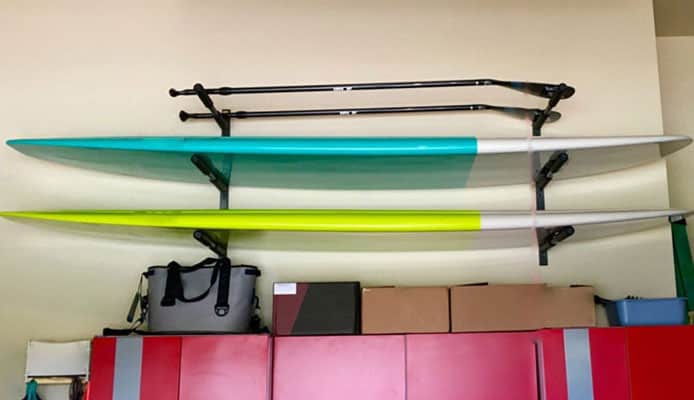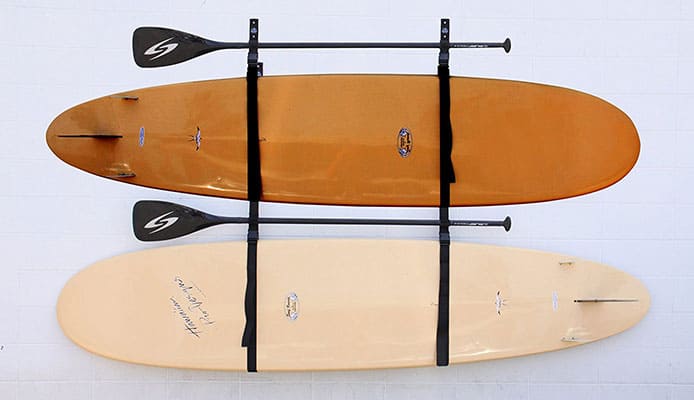
Stand up paddleboarding has quickly become one of the most popular sports in the last few months. It’s not hard to see why as the sport is a great blend of exercising and nature, giving people beautiful views while they pleasantly work their bodies. There are different kinds of stand-up paddleboards (SUPs) that need different kinds of storage, but the biggest question on every paddle border is where and how do I store my SUP?
It’s important to always store your SUP somewhere where it will be safe from the sun, heat, and any moisture in the air. This typically means storing it inside, but that’s not always a reality. Whatever you do, just keep your board safe.
The “how-to” guide on storing your board is a bit more complex. There are specific ways of positioning your SUP and a ton of tricks on how to avoid damage and keep your SUP clean.
Where to Store Your SUP
As already mentioned, it’s important to keep your SUP away from sunlight, moisture, and extreme heat. There are reasons for these things.
Your SUP can become discolored and the outside of your SUP can get damaged by the ultraviolet rays that the sun produces. If you can’t keep your SUP inside, make sure you’re storing it somewhere that’s shady. You can also add a sun-protective spray to your SUP, further protecting it if you have any concerns that sunlight may reach it.
Mold and mildew breed in damp environments. Besides being disgusting, these growths can also damage the outer part of your SUP, costing you money. When storing make sure your SUP is dry.
Extreme heat can cause problems on both the outside and inside of your SUP. The core materials of your SUP can be damaged with heat, and your SUP can also delaminate from heat. Keeping your SUP somewhere shady will also help with heat, but try to keep an eye on your SUP and make sure it isn’t getting too hot wherever you store it.
Inside vs. Outside Storage
Keeping your SUP stored somewhere inside is the best way to keep your SUP in optimal condition. Whether it’s in your house or a garage or shed, keeping it inside protects it from the sun, moisture, and heat. If you enjoy the way your SUP looks, you can even mount it on the wall like a piece of art, making a great conversation starter!
Some SUPs are twelve feet long, making it difficult to store inside, so many paddleboarders are forced to keep their SUP outside. It’s not the end of the world if you have to, just make sure to protect your SUP to save yourself time and money. You can keep it under a deck, below the overhang of a roof, or under a tarp to help keep the sun, moisture, and heat away from your SUP. Make sure to consider the following when you’re looking for somewhere to store your SUP:
- Moisture: Ensure that your SUP is protected from the weather, like rain and snow. If you decide to keep your SUP under a tarp, make sure that the tarp won’t be bogged down with water and push down on your SUP. This can also damage it.
- Sun/Heat: Keeping your SUP in a shaded area is extremely important. If you can’t find anywhere that is shady, suspending a tarp over your SUP can do the trick.
How to Store Your SUP

There are a few different ways that you can store your SUP regardless of where you’re storing it.
- On a rack: Perhaps one of the most common ways to store a SUP, many paddle boarders either build or buy a rack. The rack should have padding and/or straps to hold the board comfortably without damaging it. Racks come in different shapes and styles, but it’s important to protect the hull of your SUP no matter what kind of rack you have. There are racks that you can buy that are made specifically for paddleboards, so if you have the money, investing in one is a great idea!
- Suspended: Another great way to hold your board up is by suspending it. It’ll be out of your way and safe. Like a rail, you can purchase one specifically for SUPs or make one yourself using wide straps. Like always, it’s important to protect the hull of your SUP, so hang it with the hull facing the ceiling.
- Leaning: Leaning your board against something is one of the easiest and cheapest ways of storing your SUP. Lay your SUP on the tail or the side, making sure that the nose of the board is not on the ground. For extra protection, add some kind of padding on the ground. Some people may not have room for this considering the length of SUPs, but if you do it’s a great solution that’s easy! You can also add some kind of pegs to hold it against the wall to make sure your SUP doesn’t fall and scare you and hurt the board.
All of these are tips and tricks for typical SUPs. However, there are inflatable SUPs that can be stored a bit differently. It’s a good idea to store them as explained above to prevent creasing and deformations in your board, but that’s not always practical. Inflatable SUPs are bought because of their versatility and small size when deflated, so there are some additional tips to keep your inflatable SUP from harm.
You might also be interested in: How To Inflate Your ISUP With Your Paddle Board Pump
First, leave the valve open so any moisture doesn’t yield bacteria inside your SUP. Before storing your inflatable SUP, rinse your board to make sure it’s clean and doesn’t keep dirt kind of rack rolled up with it. If you can, don’t fully compress your inflatable SUP; keeping it rolled up loosely is best to avoid deformations. Just like a regular SUP, keeping it somewhere dry and cool is the best idea.
Storage Tips
Besides paddleboard storage locations, there are a few general tips to think about no matter the location.
- Clean your SUP. Whenever you come back from a trip, rinse off your SUP with fresh water to get rid of any sand, dirt, salt, or grim that has come from the lake. Every few months, you should also wash your SUP with a mild soap and water mixture to keep it in tip-top condition. Also, make sure your SUP is dry before you store it.
- Distribute your SUP’s weight equally. This is important since you can deform your SUP by putting too much pressure on one side of it.
- Avoid pressuring any part of your SUP, whether you’re putting your SUP on a rack, hanging it, or just leaning it against the wall. Make sure your SUP won’t be pinched by any doors or cabinets, and don’t secure it too securely as you would to the top of your car. SUPs are expensive, so you don’t want to hurt yours by storing them unwisely.
- Consider how easy your storage place is to access. Your SUP was probably bought to be used, and if you have it tucked away in the back of a messy garage or shed, it’ll be discouraging to use it. Make sure that it’s somewhere you (or whoever could be using it) can get to quickly and easily.
- Think about theft protection. SUPs can be a bit pricey, and if you use yours often, it can become a precious item. If you have to store your SUP outside, try to keep it as hidden as possible to protect it from thieves. It’s also good to make it hard to grab quickly, which can be done by using a security cable through the leash loop on your SUP. There are also locks made specifically for SUPs, so if you have to keep it outside, it may be worth investing in.
More Paddle Board Accessories Guides:
- Paddle Board Fin Replacement And Buying Guide
- How to Store a Stand Up Paddle Board
- Paddle Board Fin Replacement And Buying Guide
Paddle Boards Accessories:

